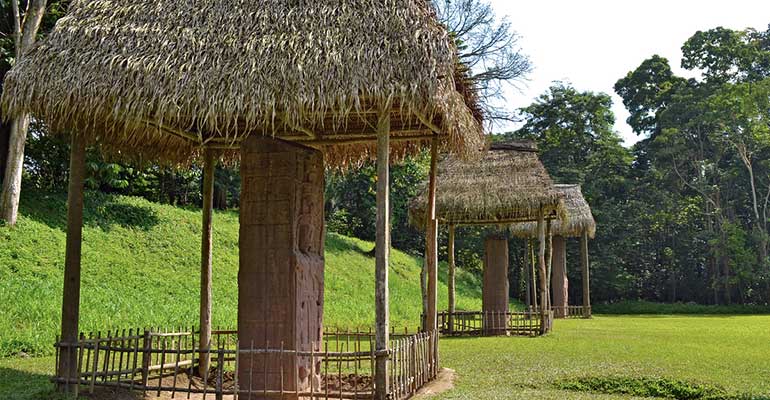Archaeology and Maya Ruins
Tikal

Tikal is one of the largest Maya cities in the world. This city is a cultural center that belongs to the Unesco since 1979.
It is estimated that the city of Tikal had a population of 100.000 to 150.000 Maya and has an area of 60 km ². The city sits 6 temples, several buildings and carved stones.
Major city ruins of Tikal.
- Gran Jaguar Temple (Temple I) measure 55 meters. This temple built in 700 represents the tomb of Hasaw Kawil Ch’an.
- Máscaras Temple (Temple II or pyramid of Luna) measure 50 meters. It’s the tomb of Hasaw Cha’an Kawil wife.
- Gran Sacerdote Temple (Temple III), is the tomb of Chi’taam. It is a preserved temple.
- Serpiente Bicéfala Temple (Temple IV) measure 64 meters.
- Temple V is the only pyramid where didn’t find a tomb.
- Inscripciones Temple (Temple VI). This temple was made for Yaxk’in Ca’an Chac.
El Mirador
The famous view of the Mirador gives an amazing view over the jungle. El Mirador is actually the pyramid of La Danta which measures 72 meters. It is the largest building of Mayan Pre-Columbian America. The second pyramid archeological site is called the Tigre pyramid which measures 55 meters.
You can go to El Mirador only in a course of 4 days (round trip ) from the town of Carmelita or you can chose for helicopter flight.
Yaxha & Topoxté

Yaxhá is an archaeological site that was a Mayan ceremonial center in Petén. It lies between the lagoons and Yaxhá Sacnab, next to this, is the site Topoxte.
You will have a panoramic view over the forest and the lakes.
You can not go by land transport to Topoxte, part of the journey is by boat.
Ceibal, Dos Pilas, Sayaxché & Cancuén

Sayaxché Petén is a city and has large natural resources. This area has several archaeological remains: Ceibal, Aguateca, Dos Pilas and Cancuén; has gaps: Petexbatún, San Juan Acul and El Rosario .
- El Ceibal: It is situated 22 km from Sayaxché. You can find, plazas, mounds and mostly beautiful stone steles.
- Aguateca: Located in a constructed bridge fault line materials through the city of Aguateca, stelae, stone troughs, etc.
- Dos Pilas: It is situated 28 km from Sayaxché. It is beautiful and pristine 2 sheds water very well preserved.
- Cancuén: The site is located on the banks of the river The Passion.
La Democracia
In the park of Democracy find the largest collection of monoliths shaped faces, back to the preshipánica time. It is a dozen of these volcanic stone sculptures.
These sculptures are rooted in the archaeological site Monte Alto. They were moved in 1960 to Democracy . Faces of Democracy exceed 1.30 meters.
Zaculeu

Zaculeu (or Saqulew in Maya and Zac Tz’otz in K’iche ‘ ) is an archaeological site in the highlands. The name means white earth. It is located near the city of Huehuetenango.
Zaculeu was settled in the fifth century. The site is completely renovated. Is open to tourism and has a small museum to visit the objects discovered.
Quiriguá

Quiriguá is a Mayan archaeological site. This site is located on the road to Copan (Honduras) to Puerto Barrios or Rio Dulce. Quirigua is an awesome site with several stelae and 33 altars carved.
Almost all of the trails were made during the reign of K’ak ‘Tiliw Yopaa Chan. Quiriguá Mayan population was at war with the long dominatio Copán on Quiriguá.
Copán (Honduras)

Copán was a governmental and ceremonial center of the Mayan civilization. It is located at the level of the border of Guatemala (aprox. 12 km) .
Copán site was discovered in 1570 by Diego García de Palacio. Archaeological excavations started depiction of the nineteenth century. It is one of the largest sites of the Mayan civilization. This city belongs to the cultural heritage of UNESCO since 1980.
You can admire the ball game is still very well preserved. It is the second largest after the game balls from the ruins of Chichen Itza in México.
